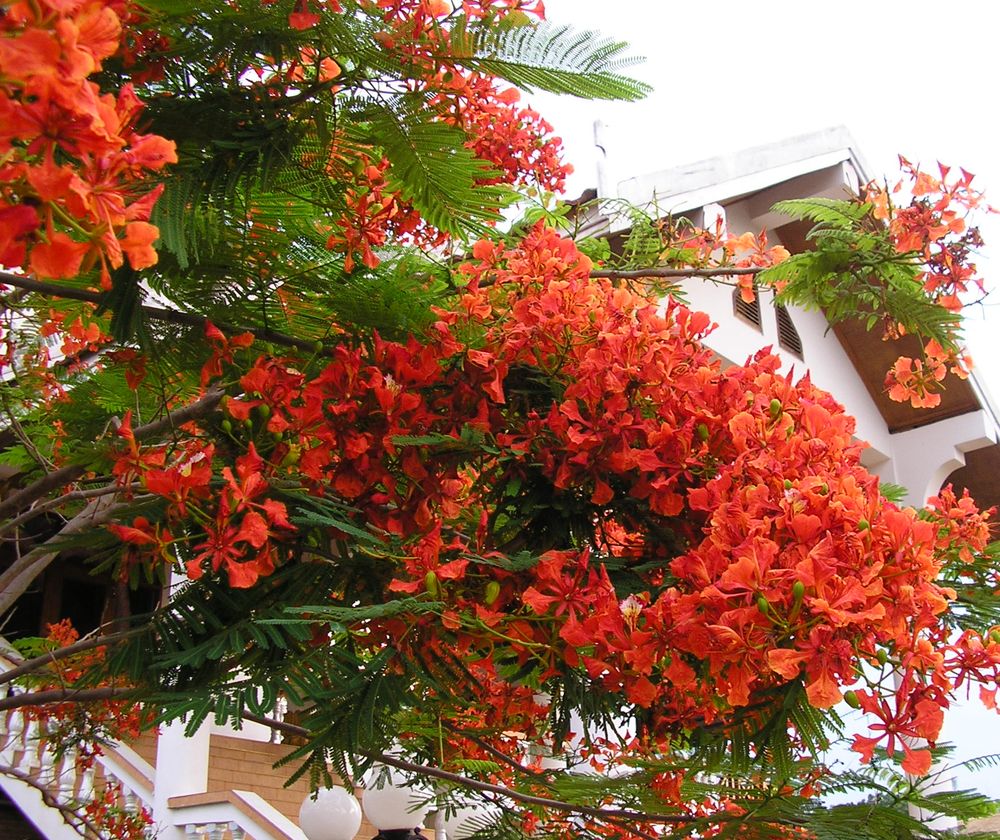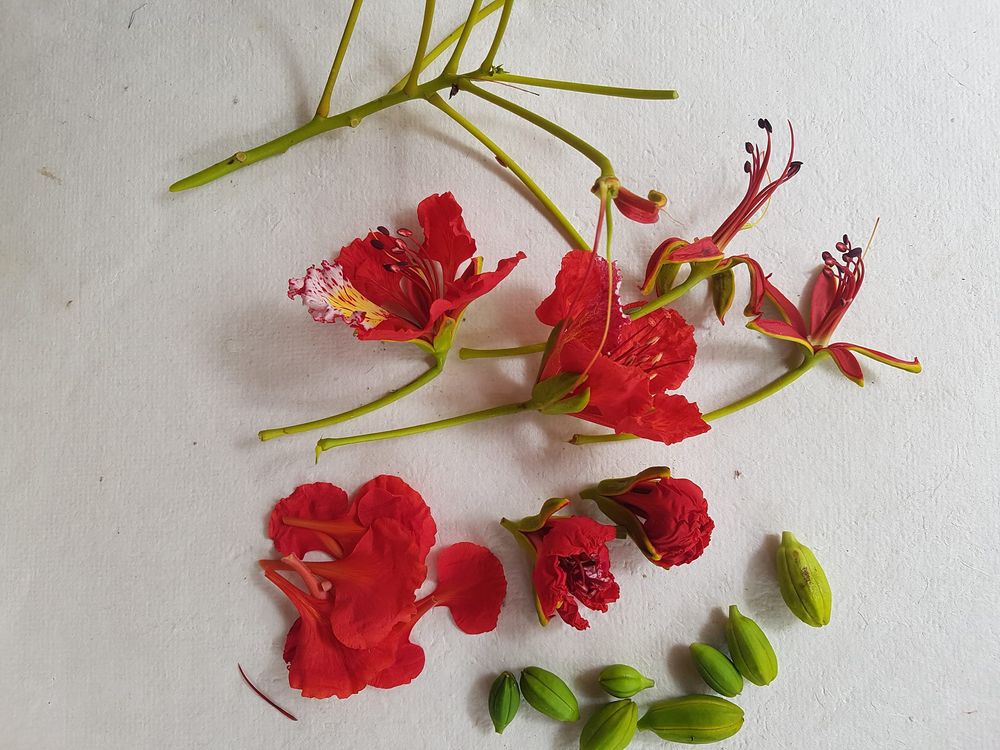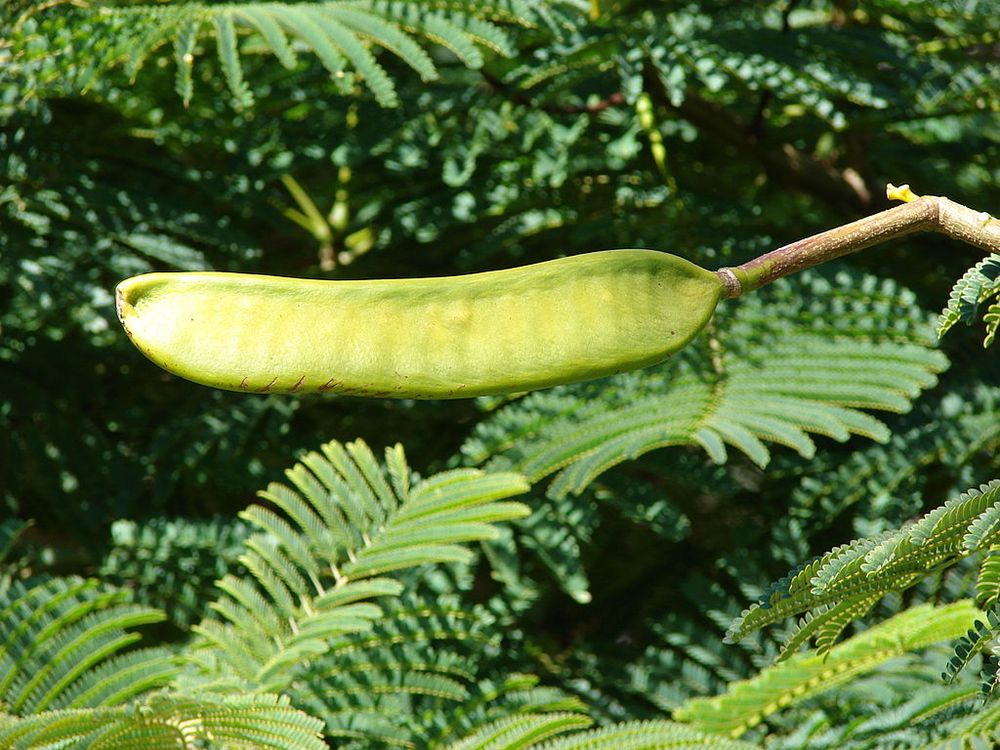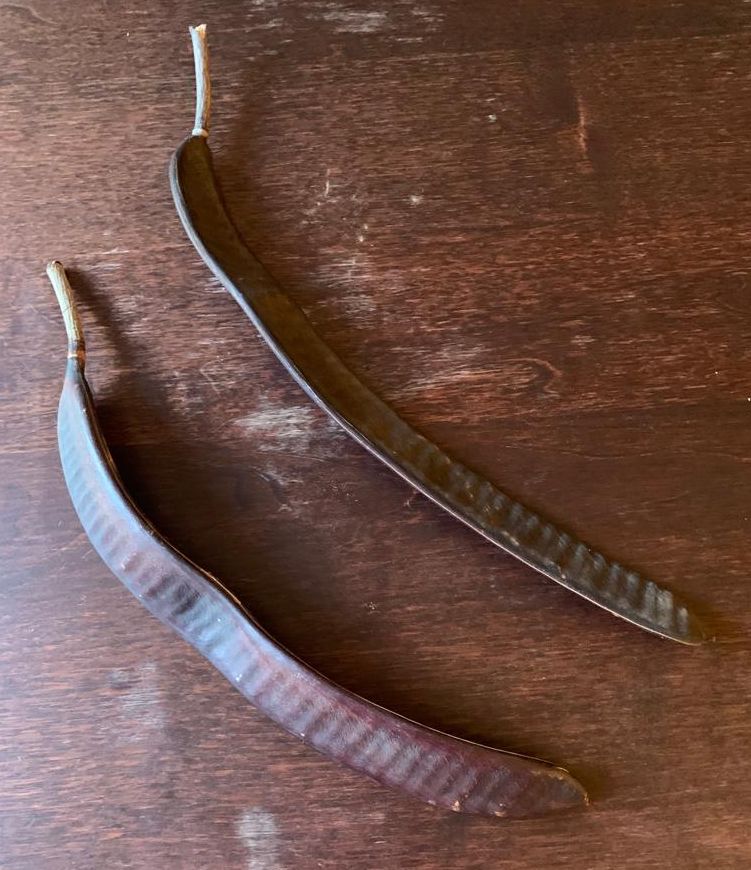The flamboyant, native to Madagascar, is, in general opinion, one of the most beautiful ornamental trees there is. Its “flamboyance” is, undoubtedly, at the origin of its Lao name which means “to dazzle”. What is certain is that it is also called haang gniou, “mosquito tail” or nok gnoung flang, “French peacock”. However, a controversy remains about the name of this tree and which concerns the city of Luang Prabang. Indeed, the capital of northern Laos was called in the 13th and 14th centuries Xieng Dong Xieng Thong, unanimously translated as “city of the Dong (a river) city of the Flamboyant”, or thong is the name of another legume, certainly with very beautiful red flowers, Erythrina Indica, but not that of the Flamboyant.
It is a large tree, about fifteen meters, with deciduous leaves. Its branches are very spreading, sometimes horizontal. Its large leaves are paripinnate, with 20 to 30 pairs of leaflets. At the end of the dry season, from May in Laos, it flowers abundantly. Its flowers, usually orange-red, can also be yellow. Its fruits are flattened pods, with woody valves, 30 to 60 cm long. They contain about thirty grey and hard seeds.
This beautiful tree is especially appreciated for its shade and for its sumptuous flowering. However, the seeds make it possible to make pretty necklaces and, here and there, medicinal uses are proposed; thus the leaves would be effective against rheumatism.
Finally, note that this tree is listed on the IUCN red list.
Le flamboyant, originaire de Madagascar, est, de l’avis général, l’un des plus beaux arbres d’ornement qui soient. Sa « flamboyance » est, sans doute, à l’origine de son nom lao qui signifie « éblouir ». Ce qui est certain c’est qu’on le nomme aussi haang gniou, « queue de moustique » ou nok gnoung flang, « paon français ». Cependant une polémique subsiste à propos du nom de cet arbre et qui concerne la ville de Louang Prabang. En effet la capitale du Nord Laos s’est appelée aux XIII° et XIV° siècles Xieng Dong Xieng Thong, traduit unanimement par « ville du Dong (une rivière) ville du Flamboyant », or thong est le nom d’une autre légumineuse, certes aux très belles fleurs rouges, Erythrina Indica, mais pas celui du Flamboyant.
C’est un grand arbre, d’une quinzaine de mètres, à feuilles caduques. Ses branches sont très étalées, parfois horizontales. Ses grandes feuilles sont paripennées, de 20 à 30 paires de folioles. A la fin de la saison sèche, dès le mois de mai au Laos, il fleurit abondamment. Ses fleurs, en général rouge orangé, peuvent aussi être jaunes. Ses fruits sont des gousses aplaties, à valves ligneuses, de 30 à 60 cm de long. Elles contiennent une trentaine de graines grises et dures.
Ce bel arbre est surtout apprécié pour son ombre et pour sa floraison somptueuse. Cependant les graines permettent de faire de jolis colliers et, çà et là, des utilisations médicinales sont proposées ; ainsi les feuilles seraient efficaces contre les rhumatismes.
Notons enfin que cet arbre est inscrit sur la liste rouge de l’UICN.




The flamboyant, native to Madagascar, is, in general opinion, one of the most beautiful ornamental trees there is. Its “flamboyance” is, undoubtedly, at the origin of its Lao name which means “to dazzle”. What is certain is that it is also called haang gniou, “mosquito tail” or nok gnoung flang, “French peacock”. However, a controversy remains about the name of this tree and which concerns the city of Luang Prabang. Indeed, the capital of northern Laos was called in the 13th and 14th centuries Xieng Dong Xieng Thong, unanimously translated as “city of the Dong (a river) city of the Flamboyant”, or thong is the name of another legume, certainly with very beautiful red flowers, Erythrina Indica, but not that of the Flamboyant.
It is a large tree, about fifteen meters, with deciduous leaves. Its branches are very spreading, sometimes horizontal. Its large leaves are paripinnate, with 20 to 30 pairs of leaflets. At the end of the dry season, from May in Laos, it flowers abundantly. Its flowers, usually orange-red, can also be yellow. Its fruits are flattened pods, with woody valves, 30 to 60 cm long. They contain about thirty grey and hard seeds.
This beautiful tree is especially appreciated for its shade and for its sumptuous flowering. However, the seeds make it possible to make pretty necklaces and, here and there, medicinal uses are proposed; thus the leaves would be effective against rheumatism.
Finally, note that this tree is listed on the IUCN red list.
Le flamboyant, originaire de Madagascar, est, de l’avis général, l’un des plus beaux arbres d’ornement qui soient. Sa « flamboyance » est, sans doute, à l’origine de son nom lao qui signifie « éblouir ». Ce qui est certain c’est qu’on le nomme aussi haang gniou, « queue de moustique » ou nok gnoung flang, « paon français ». Cependant une polémique subsiste à propos du nom de cet arbre et qui concerne la ville de Louang Prabang. En effet la capitale du Nord Laos s’est appelée aux XIII° et XIV° siècles Xieng Dong Xieng Thong, traduit unanimement par « ville du Dong (une rivière) ville du Flamboyant », or thong est le nom d’une autre légumineuse, certes aux très belles fleurs rouges, Erythrina Indica, mais pas celui du Flamboyant.
C’est un grand arbre, d’une quinzaine de mètres, à feuilles caduques. Ses branches sont très étalées, parfois horizontales. Ses grandes feuilles sont paripennées, de 20 à 30 paires de folioles. A la fin de la saison sèche, dès le mois de mai au Laos, il fleurit abondamment. Ses fleurs, en général rouge orangé, peuvent aussi être jaunes. Ses fruits sont des gousses aplaties, à valves ligneuses, de 30 à 60 cm de long. Elles contiennent une trentaine de graines grises et dures.
Ce bel arbre est surtout apprécié pour son ombre et pour sa floraison somptueuse. Cependant les graines permettent de faire de jolis colliers et, çà et là, des utilisations médicinales sont proposées ; ainsi les feuilles seraient efficaces contre les rhumatismes.
Notons enfin que cet arbre est inscrit sur la liste rouge de l’UICN.








The flamboyant, native to Madagascar, is, in general opinion, one of the most beautiful ornamental trees there is. Its “flamboyance” is, undoubtedly, at the origin of its Lao name which means “to dazzle”. What is certain is that it is also called haang gniou, “mosquito tail” or nok gnoung flang, “French peacock”. However, a controversy remains about the name of this tree and which concerns the city of Luang Prabang. Indeed, the capital of northern Laos was called in the 13th and 14th centuries Xieng Dong Xieng Thong, unanimously translated as “city of the Dong (a river) city of the Flamboyant”, or thong is the name of another legume, certainly with very beautiful red flowers, Erythrina Indica, but not that of the Flamboyant.
It is a large tree, about fifteen meters, with deciduous leaves. Its branches are very spreading, sometimes horizontal. Its large leaves are paripinnate, with 20 to 30 pairs of leaflets. At the end of the dry season, from May in Laos, it flowers abundantly. Its flowers, usually orange-red, can also be yellow. Its fruits are flattened pods, with woody valves, 30 to 60 cm long. They contain about thirty grey and hard seeds.
This beautiful tree is especially appreciated for its shade and for its sumptuous flowering. However, the seeds make it possible to make pretty necklaces and, here and there, medicinal uses are proposed; thus the leaves would be effective against rheumatism.
Finally, note that this tree is listed on the IUCN red list.
Le flamboyant, originaire de Madagascar, est, de l’avis général, l’un des plus beaux arbres d’ornement qui soient. Sa « flamboyance » est, sans doute, à l’origine de son nom lao qui signifie « éblouir ». Ce qui est certain c’est qu’on le nomme aussi haang gniou, « queue de moustique » ou nok gnoung flang, « paon français ». Cependant une polémique subsiste à propos du nom de cet arbre et qui concerne la ville de Louang Prabang. En effet la capitale du Nord Laos s’est appelée aux XIII° et XIV° siècles Xieng Dong Xieng Thong, traduit unanimement par « ville du Dong (une rivière) ville du Flamboyant », or thong est le nom d’une autre légumineuse, certes aux très belles fleurs rouges, Erythrina Indica, mais pas celui du Flamboyant.
C’est un grand arbre, d’une quinzaine de mètres, à feuilles caduques. Ses branches sont très étalées, parfois horizontales. Ses grandes feuilles sont paripennées, de 20 à 30 paires de folioles. A la fin de la saison sèche, dès le mois de mai au Laos, il fleurit abondamment. Ses fleurs, en général rouge orangé, peuvent aussi être jaunes. Ses fruits sont des gousses aplaties, à valves ligneuses, de 30 à 60 cm de long. Elles contiennent une trentaine de graines grises et dures.
Ce bel arbre est surtout apprécié pour son ombre et pour sa floraison somptueuse. Cependant les graines permettent de faire de jolis colliers et, çà et là, des utilisations médicinales sont proposées ; ainsi les feuilles seraient efficaces contre les rhumatismes.
Notons enfin que cet arbre est inscrit sur la liste rouge de l’UICN.


